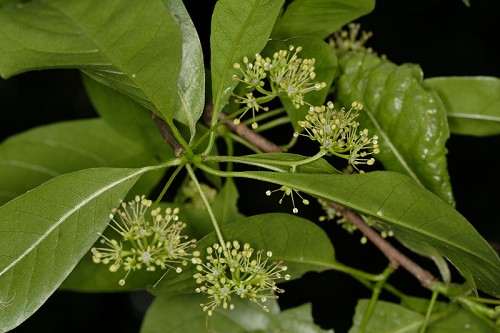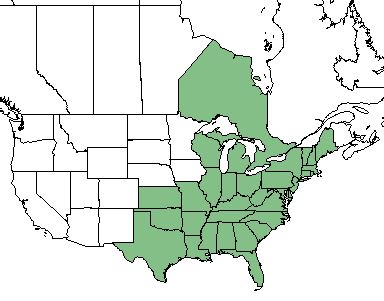Difference between revisions of "Nyssa sylvatica"
(→Ecology) |
|||
| Line 48: | Line 48: | ||
===Pollination and use by animals=== <!--Herbivory, granivory, insect hosting, etc.--> | ===Pollination and use by animals=== <!--Herbivory, granivory, insect hosting, etc.--> | ||
| − | ''Nyssa sylvatica'' has been observed to host | + | ''Nyssa sylvatica'' has been observed to host aphids such as ''Aphis sp.'' (family Aphididae), leaf-footed bugs such as ''Leptoglossus oppositus'' (family Coreidae), treehoppers such as ''Telamona monticola'' (family Membracidae), plant bugs such as ''Plagiognathus albatus'' (family Miridae), and ground-nesting bees from the Andrenidae family such as ''Andrena atlantica'' and ''A. hippotes''.<ref>Discoverlife.org [https://www.discoverlife.org/20/q?search=Bidens+albaDiscoverlife.org|Discoverlife.org]</ref> ''N. sylvatica'' has medium palatability to browsing animals.<ref name= "USDA Plant Database"/> |
<!--==Diseases and parasites==--> | <!--==Diseases and parasites==--> | ||
Revision as of 19:53, 18 June 2021
Common name: blackgum[1], sour gum[2], pepperidge[2]
| Nyssa sylvatica | |
|---|---|

| |
| Photo by John Gwaltney at the Southeasten Flora Database | |
| Scientific classification | |
| Kingdom: | Plantae |
| Division: | Magnoliophyta - Flowering plants |
| Class: | Magnoliopsida - Dicots |
| Order: | Cornales |
| Family: | Cornaceae |
| Genus: | Nyssa |
| Species: | N. sylvatica |
| Binomial name | |
| Nyssa sylvatica Marshall | |

| |
| Natural range of Nyssa sylvatica from USDA NRCS Plants Database. | |
Contents
Taxonomic Notes
Synonyms: none.[3]
Varieties: none.[3]
Description
N. sylvatica is a perennial tree of the Cornaceae family native to North America and Canada.[1]
N. sylvatica's fruit and flowers are pistillate and grow in 3-5 per peduncle. The fruit is 6-15 mm long and colored black-blue at maturity, with a rigid to smooth stone. The thin, pliable leaves are entire with irregular teeth near its acuminate apex. They are 18 cm long and 10 cm wide, being widest at the middle. The leaf petioles are 0.5-2.0 cm long. The bark is rough, divided by deep vertical and horizontal furrows into a pattern of squarish checks.[3]
Distribution
N. sylvatica ranges from southern Maine west to Michigan and southeast Wisconsin, south to central peninsular Florida, and west to eastern Texas and eastern Oklahoma.[3]
Ecology
Habitat
N. sylvatica proliferates in dry or mesic upland forests, less commonly in bottomlands, pine savannas, or upland depressions, where occasionally inundated briefly.[2] Specimens have been collected from residential areas, upland open woodlands, mixed upland hardwoods, creek floodplains, mesic wooded bluffs, flatwoods, lakeshores, river floodplain, live oak stands at cypress depressions, pond edges, slash pine flatwoods, wet hammocks, cypress-gum ponds, and pine woodlands.[4] N. sylvatica responds negatively to agricultural-based soil disturbance in South Carolina coastal plain communities. This marks it as an indicator species for remnant woodland.[5] N. sylvatica responds positively or not at all to soil disturbance by improvement logging in Mississippi.[6] However, it does not respond to soil disturbance by clearcutting and chopping in North Florida flatwoods forests.[7] N. sylvatica responds both positively and negatively to soil disturbance by roller chopping and disturbance by a KG blade in East Texas Loblolly Pine-Hardwood Forests.[8]
Nyssa sylvatica is an indicator species for the North Florida Wet Flatwoods community type as described in Carr et al. (2010).[9]
Phenology
N. sylvatica has been observed flowering April through June and fruiting August through October.[3]
Seed dispersal
This species is thought to be dispersed by consumption by vertebrates.[10]
Fire ecology
N. sylvatica is not fire resistant and has low fire tolerance.[1]
Pollination and use by animals
Nyssa sylvatica has been observed to host aphids such as Aphis sp. (family Aphididae), leaf-footed bugs such as Leptoglossus oppositus (family Coreidae), treehoppers such as Telamona monticola (family Membracidae), plant bugs such as Plagiognathus albatus (family Miridae), and ground-nesting bees from the Andrenidae family such as Andrena atlantica and A. hippotes.[11] N. sylvatica has medium palatability to browsing animals.[1]
Conservation, cultivation, and restoration
Cultural use
Photo Gallery
References and notes
- ↑ 1.0 1.1 1.2 1.3 USDA Plant Database https://plants.usda.gov/core/profile?symbol=NYSY
- ↑ 2.0 2.1 2.2 Weakley, A. S. (2015). Flora of the Southern and Mid-Atlantic States. Chapel Hill, NC, University of North Carolina Herbarium.
- ↑ 3.0 3.1 3.2 3.3 3.4 Weakley, A.S. 2015. Flora of the southern and mid-atlantic states. Working Draft of 21 May 2015. University of North Carolina at Chapel Hill, Chapel Hill, North Carolina.
- ↑ URL: http://herbarium.bio.fsu.edu. Last accessed: June 2018. Collectors: Loran C. Anderson, R.K. Godfrey, Angus Gholson, Wilson Baker, Patricia Elliot, A.F. Clewell, E. Tyson, E.A. Hebb, H. Kurz, Richard Mitchell, D. B. Ward, W.G. D'Arcy, C. Monk, H. Larry Stripling, Elmar Prichard, R. Komarek, R. Jean, Kevin Oakes, Cecil Slaughter, Marc Minno, T. MacClendon, K. MacClendon, Tom Gilpin, William Platt, Richard Carter, W. Baker, Sidney McDaniel, Andre Clewell, Walter S. Judd, Bob Simmons, Dana Griffin, Bruce Hansen, JoAnn Hansen, R.F. Doren, Gwynn Ramsey, E.S. FOrd, P.L Redfearn, Richard Houk, William Lindsey, R. Kral, Robert Lazor, R. A> Norris, K. Craddock Burks, K.M. Meyer. States and counties: Florida (Liberty, Leon, Walton, Suwannee, Okaloosa, Wakulla, Jefferson, Jackson, Gadsden, Columbia, Bay, Alachua, Lake, Baker, Calhoun, Osceola, Clay, Washington, Dixie, Flagler, Franklin, Madison, St. Johns, Taylor, Volusia) North Carolina (Bladen) Georgia (Grady, Thomas, Grady) Tennessee (Macon)
- ↑ Brudvig, L.A., E Grman, C.W. Habeck, and J.A. Ledvina. (2013). Strong legacy of agricultural land use on soils and understory plant communities in longleaf pine woodlands. Forest Ecology and Management 310: 944-955.
- ↑ McComb, W.C. and R.E. Noble. (1982). Response of Understory Vegetation to Improvement Cutting and Physiographic Site in Two Mid-South Forest Stands. Southern Appalachian Botanical Society 47(1):60-77.
- ↑ Moore, W.H., B.F. Swindel, and W.S. Terry. (1982). Vegetative Response to Clearcutting and Chopping in a North Florida Flatwoods Forest. Journal of Range Management 35(2):214-218.
- ↑ Stransky, J.J., J.C. Huntley, and Wanda J. Risner. (1986). Net Community Production Dynamics in the Herb-Shrub Stratum of a Loblolly Pine-Hardwood Forest: Effects of CLearcutting and Site Preparation. Gen. Tech. Rep. SO-61. New Orleans, LA: U.S. Dept of Agriculture, Forest Service, Southern Forest Experiment Station. 11 p.
- ↑ Carr, S.C., K.M. Robertson, and R.K. Peet. 2010. A vegetation classification of fire-dependent pinelands of Florida. Castanea 75:153-189.
- ↑ Kirkman, L. Katherine. Unpublished database of seed dispersal mode of plants found in Coastal Plain longleaf pine-grasslands of the Jones Ecological Research Center, Georgia.
- ↑ Discoverlife.org [1]